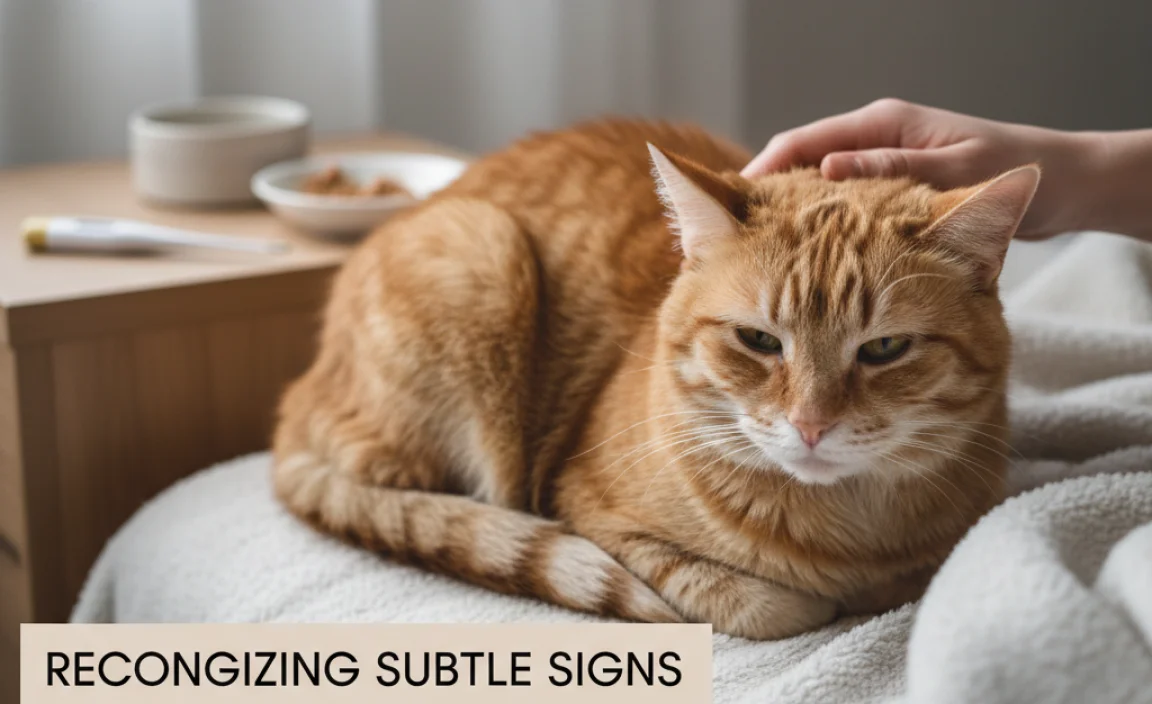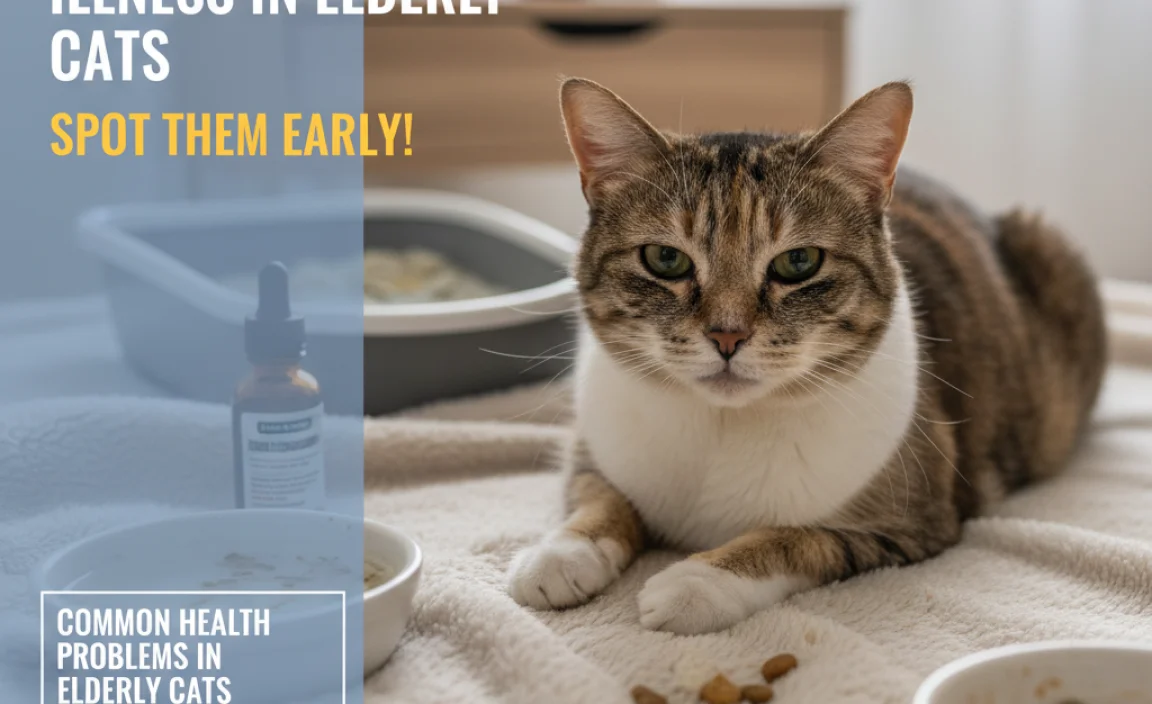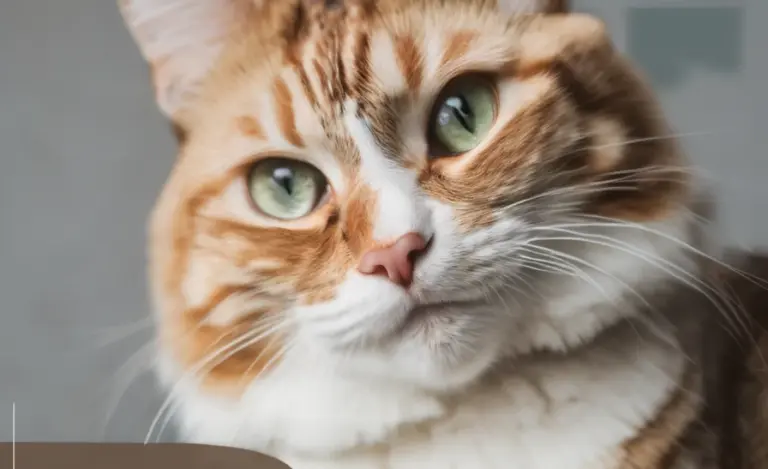Signs of Illness in Elderly Cats: Spot Them Early!
Quick Summary: Spotting illness in elderly cats involves observing subtle changes in behavior, appetite, and physical appearance. Key signs include weight loss, decreased grooming, changes in litter box habits, mobility issues, and increased vocalization. Regular vet check-ups are crucial for early detection and management of age-related diseases in senior cats.
As our beloved British Shorthairs gracefully age, they become more susceptible to various health issues. Unlike kittens, senior cats often mask their discomfort, making it crucial for us, as their devoted owners, to recognize subtle signs of illness. It can be frustrating trying to decode what’s “off” with your furry friend, but with careful observation, you can catch problems early and ensure they receive the best possible care. Let’s explore the key indicators that suggest your elderly cat might need a check-up.
Recognizing the Subtle Signs of Illness in Elderly Cats

Elderly cats, generally those over the age of 11, require extra attention. As they age, their bodies change, and they become more vulnerable to diseases. Here’s what to watch for:
1. Changes in Appetite and Weight
A noticeable change in your cat’s eating habits can be a significant indicator of underlying health issues. Keep an eye out for these signs:
- Loss of Appetite: If your cat consistently eats less than usual or refuses food altogether, it’s time to investigate.
- Increased Appetite: Sometimes, a medical condition can cause a cat to eat more but still lose weight. This is particularly concerning.
- Weight Loss: Unexplained weight loss is a red flag. You might notice your cat feels thinner, or their spine and ribs become more prominent.
- Weight Gain: While less alarming than weight loss, sudden weight gain can also signal health problems, such as fluid retention or decreased mobility leading to obesity.
If you notice any of these changes, it’s important to consult with your veterinarian to determine the underlying cause.
2. Altered Litter Box Habits
Changes in your cat’s litter box habits can indicate several health issues, especially related to the urinary tract or digestive system. Here’s what to watch for:
- Increased Urination: If your cat is suddenly urinating more frequently or producing larger volumes of urine, it could be a sign of kidney disease or diabetes.
- Straining to Urinate: Difficulty or pain while urinating can indicate a urinary tract infection or bladder stones.
- Blood in Urine: This is always a cause for concern and should be addressed by a vet immediately.
- Changes in Stool: Diarrhea or constipation that lasts more than a day or two warrants a vet visit.
- Avoiding the Litter Box: If your cat starts urinating or defecating outside the litter box, it could be due to pain or discomfort associated with using the box.
Monitor your cat’s litter box habits daily to catch any changes early. According to the RSPCA, changes in urination or defecation habits are common indicators of underlying health problems that need veterinary attention.
3. Decreased Grooming and Changes in Coat Condition
Cats are meticulous groomers, so a decline in their grooming habits can be a telltale sign of illness. Here’s what to look for:
- Matted Fur: If your cat stops grooming, their fur can become matted and tangled, especially in long-haired breeds like British Shorthairs.
- Dull Coat: A healthy cat has a shiny, glossy coat. A dull, lackluster coat can indicate poor nutrition or an underlying health problem.
- Overgrooming: Sometimes, cats will excessively groom a particular area due to pain or discomfort. This can lead to bald spots or skin irritation.
- Greasy Fur: Changes in skin oil production can make the fur feel greasy or oily.
Regularly grooming your cat can help you spot changes in their coat and skin. If you notice any abnormalities, consult your vet.
4. Mobility Issues and Stiffness
As cats age, they can develop arthritis and other joint problems that affect their mobility. Watch for these signs:
- Stiffness: Your cat may move more slowly or stiffly, especially after resting.
- Difficulty Jumping: If your cat hesitates or struggles to jump onto furniture or other surfaces, it could be due to joint pain.
- Limping: A noticeable limp is a clear sign of discomfort or injury.
- Reduced Activity: Your cat may spend more time sleeping and less time playing or exploring.
- Changes in Gait: Watch for any changes in the way your cat walks, such as a shuffling gait or reluctance to put weight on a particular leg.
Providing soft bedding and ramps can help make your cat more comfortable. Consult your vet about pain management options.
5. Behavioral Changes
Changes in your cat’s behavior can be subtle but significant indicators of illness. Pay attention to these signs:
- Increased Vocalization: Some cats become more vocal when they’re in pain or disoriented.
- Lethargy: A decrease in energy levels and overall activity can indicate illness.
- Hiding: Cats often hide when they’re not feeling well.
- Irritability: A normally friendly cat may become irritable or aggressive if they’re in pain.
- Confusion or Disorientation: Cognitive dysfunction, similar to dementia in humans, can cause confusion and disorientation in elderly cats.
Note any changes in your cat’s behavior and discuss them with your vet. According to the Cornell Feline Health Center, behavioral changes are often early indicators of underlying health issues that require veterinary attention.
6. Dental Problems
Dental disease is common in older cats and can cause significant pain and discomfort. Look for these signs:
- Bad Breath: Persistent bad breath is a classic sign of dental problems.
- Drooling: Excessive drooling can indicate dental pain or infection.
- Difficulty Eating: Your cat may have trouble chewing dry food or may drop food while eating.
- Red or Swollen Gums: Inflamed gums are a sign of gingivitis or periodontitis.
- Loose Teeth: Loose or missing teeth can indicate advanced dental disease.
Regular dental check-ups and cleanings are essential for maintaining your cat’s oral health. Your vet can recommend the best course of action for addressing dental problems.
7. Eye and Ear Issues
Changes in your cat’s eyes and ears can indicate various health problems. Here’s what to watch for:
- Discharge: Discharge from the eyes or ears can indicate an infection.
- Cloudiness: Cloudiness in the eyes can be a sign of cataracts or other eye problems.
- Redness: Redness or inflammation around the eyes or ears can indicate irritation or infection.
- Head Shaking: Frequent head shaking can indicate an ear infection or other ear problem.
- Scratching at Ears: Excessive scratching at the ears can also indicate an ear infection or mites.
If you notice any of these signs, consult your vet for diagnosis and treatment.
8. Skin Changes
Skin problems can be a sign of underlying health issues, allergies, or infections. Watch for these signs:
- Hair Loss: Bald patches or thinning hair can indicate a skin condition or underlying illness.
- Itching: Excessive scratching, licking, or biting at the skin can indicate allergies, parasites, or infections.
- Redness: Red, inflamed skin can be a sign of irritation or infection.
- Lumps or Bumps: Any new lumps or bumps should be checked by a vet.
- Dry, Flaky Skin: Dry, flaky skin can indicate dehydration or a skin condition.
Regularly check your cat’s skin for any abnormalities and consult your vet if you notice anything unusual.
9. Respiratory Issues
Respiratory problems can be serious and require prompt veterinary attention. Watch for these signs:
- Coughing: Persistent coughing can indicate asthma, bronchitis, or other respiratory infections.
- Sneezing: Frequent sneezing can be a sign of an upper respiratory infection.
- Wheezing: Wheezing is a sign of airway obstruction or inflammation.
- Difficulty Breathing: Labored breathing or rapid breathing is a medical emergency and requires immediate veterinary care.
- Nasal Discharge: Discharge from the nose can indicate an upper respiratory infection.
If your cat is having trouble breathing, seek veterinary care immediately.
Creating a Comfortable Environment for Your Senior Cat

As cats age, they need some environmental adjustments to maintain a good quality of life. Here are a few tips:
- Soft Bedding: Provide soft, comfortable bedding in a warm, draft-free area.
- Easy Access: Make sure your cat can easily access food, water, and the litter box. Consider using ramps or steps to help them reach their favorite spots.
- Regular Grooming: Continue to groom your cat regularly to help them maintain a healthy coat and prevent matting.
- Quiet Spaces: Provide quiet, safe spaces where your cat can retreat when they need to rest.
- Warmth: Elderly cats are more sensitive to cold, so make sure they have access to warm areas, especially during the winter months.
The Importance of Regular Veterinary Check-ups

Regular veterinary check-ups are crucial for early detection and management of age-related diseases in senior cats. Here’s why:
- Early Detection: Regular check-ups allow your vet to detect health problems early, when they are more treatable.
- Preventive Care: Your vet can recommend preventive care measures, such as vaccinations and parasite control, to help keep your cat healthy.
- Monitoring Chronic Conditions: If your cat has a chronic condition, such as kidney disease or diabetes, regular check-ups allow your vet to monitor their condition and adjust their treatment plan as needed.
- Pain Management: Your vet can assess your cat’s pain levels and recommend appropriate pain management options.
- Nutritional Guidance: Your vet can provide guidance on the best diet for your senior cat’s specific needs.
The International Cat Association (TICA) recommends that senior cats have veterinary check-ups at least twice a year. These regular visits can help ensure your cat stays healthy and comfortable in their golden years.
Common Health Problems in Elderly Cats

Elderly cats are prone to certain health problems. Being aware of these conditions can help you recognize the signs early and seek appropriate treatment.
| Condition | Symptoms | Treatment |
|---|---|---|
| Kidney Disease | Increased thirst and urination, weight loss, decreased appetite, vomiting | Special diet, medication, fluid therapy |
| Diabetes | Increased thirst and urination, increased appetite, weight loss | Insulin injections, special diet |
| Arthritis | Stiffness, difficulty jumping, limping, reduced activity | Pain medication, joint supplements, physical therapy |
| Hyperthyroidism | Weight loss, increased appetite, increased activity, vomiting, diarrhea | Medication, radioactive iodine therapy, surgery |
| Dental Disease | Bad breath, drooling, difficulty eating, red or swollen gums | Dental cleaning, tooth extraction, antibiotics |
| Cancer | Varies depending on the type of cancer | Surgery, chemotherapy, radiation therapy |
| Cognitive Dysfunction | Disorientation, confusion, changes in sleep patterns, increased vocalization | Medication, environmental enrichment |
When to Consult a Veterinarian

It’s always better to err on the side of caution when it comes to your cat’s health. Consult your veterinarian if you notice any of the following signs:
- Sudden changes in behavior or appetite
- Lethargy or weakness
- Difficulty breathing
- Vomiting or diarrhea that lasts more than 24 hours
- Blood in urine or stool
- Seizures
- Collapse
- Any other concerning symptoms
FAQ About Signs of Illness in Elderly Cats
Here are some frequently asked questions about recognizing and addressing illness in elderly cats:
1. At what age is a cat considered elderly?
A cat is generally considered elderly around the age of 11, although many cats live well into their late teens or early twenties.
2. How often should I take my senior cat to the vet?
Senior cats should have veterinary check-ups at least twice a year, or more frequently if they have any underlying health conditions.
3. What are some common health problems in elderly cats?
Common health problems in elderly cats include kidney disease, diabetes, arthritis, hyperthyroidism, and dental disease.
4. How can I tell if my cat is in pain?
Signs of pain in cats can be subtle, but may include changes in behavior, decreased appetite, hiding, and reluctance to move. If you suspect your cat is in pain, consult your veterinarian.
5. What can I do to make my senior cat more comfortable?
Provide soft bedding, easy access to food, water, and the litter box, regular grooming, and a quiet, safe environment.
6. Is it normal for elderly cats to lose weight?
While some weight loss can be normal in elderly cats due to muscle loss, significant or unexplained weight loss should always be investigated by a vet.
7. What are signs of cognitive dysfunction in elderly cats?
Signs of cognitive dysfunction include disorientation, confusion, changes in sleep patterns, increased vocalization, and decreased interaction with family members.
Conclusion
Recognizing the signs of illness in elderly cats is essential for ensuring they receive the care and attention they need to live comfortably in their senior years. By paying close attention to changes in their behavior, appetite, and physical condition, and by scheduling regular veterinary check-ups, you can help your furry friend stay healthy and happy for as long as possible. As a British Shorthair owner, you play a crucial role in safeguarding your cat’s health and well-being, ensuring they enjoy their golden years with grace and dignity. Remember, a little extra care and attention can make a world of difference in your senior cat’s quality of life.




